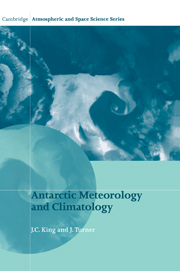Book contents
- Frontmatter
- Contents
- Preface
- Chapter 1 Introduction
- Chapter 2 Observations and instrumentation
- Chapter 3 Physical climatology
- Chapter 4 The large-scale circulation of the Antarctic atmosphere
- Chapter 5 Synoptic-scale weather systems and fronts
- Chapter 6 Mesoscale systems and processes
- Chapter 7 Climate variability and change
- Appendix A A chronological list of stations that have made multiyear meteorological observations in the Antarctic and on the sub-Antarctic islands
- Appendix B A chronological list of automatic weather stations that have been deployed in the Antarctic and on the sub-Antarctic Islands
- References
- Index
Chapter 7 - Climate variability and change
Published online by Cambridge University Press: 02 December 2009
- Frontmatter
- Contents
- Preface
- Chapter 1 Introduction
- Chapter 2 Observations and instrumentation
- Chapter 3 Physical climatology
- Chapter 4 The large-scale circulation of the Antarctic atmosphere
- Chapter 5 Synoptic-scale weather systems and fronts
- Chapter 6 Mesoscale systems and processes
- Chapter 7 Climate variability and change
- Appendix A A chronological list of stations that have made multiyear meteorological observations in the Antarctic and on the sub-Antarctic islands
- Appendix B A chronological list of automatic weather stations that have been deployed in the Antarctic and on the sub-Antarctic Islands
- References
- Index
Summary
In common with that of the northern polar regions, the Antarctic climate exhibits a much greater degree of inter-annual and inter-decadal variability than that which is observed at lower latitudes. Although the reasons for this are not fully understood, it is clear that the complex interactions between atmospheric circulation, the oceans and the cryosphere can give rise to a number of positive feedbacks that can result in enhanced climate variability. In the first section of this chapter we shall describe some aspects of the variability of the present-day Antarctic climate and examine possible mechanisms thought to be responsible for driving the observed variations. Some links have been established between climate variations in Antarctica and those occurring elsewhere. We discuss such ‘teleconnections’ in Section 7.2. Finally, in Section 7.3, we consider how the Antarctic climate might change as a result of global warming brought about by the release of ‘greenhouse’ gases into the atmosphere. The response of the Antarctic ice sheets to such warming and the consequences for global sea level changes have aroused much interest in recent years.
Our understanding of the nature of climate variability in Antarctica is necessarily limited because the available climate records are short and restricted in geographical coverage. Very few climatological stations were in operation before the International Geophysical Year of 1957/58 and, even after the IGY, most stations were established in coastal regions. Only two stations have operated on the East Antarctic plateau for longer than 20 years and, apart from the west coast of the Antarctic Peninsula, West Antarctica is almost devoid of long-term climatological observations.
- Type
- Chapter
- Information
- Antarctic Meteorology and Climatology , pp. 341 - 373Publisher: Cambridge University PressPrint publication year: 1997

